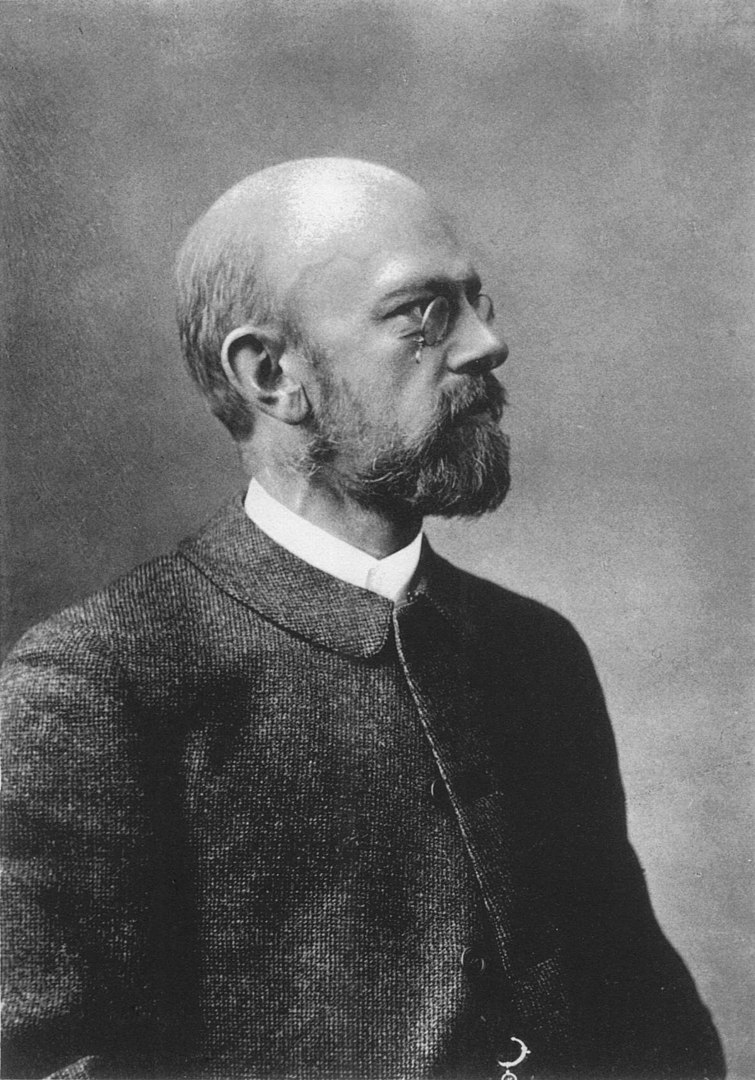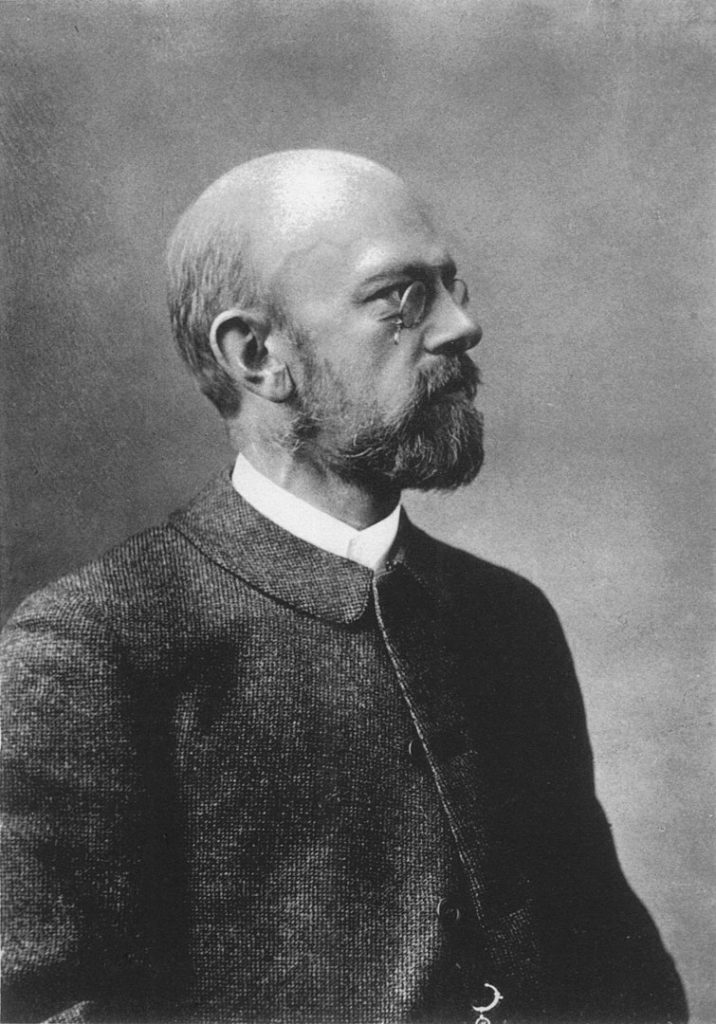
David Hilbert Photo by Unknown Author Wikimedia
Top 10 Remarquable Facts about David Hilbert
David Hilbert was born on January 23, 1862, in Konigsberg, Prussia and died on February 14, 1943, in Gottingen, Germany. He was a German mathematician who reduced geometry to a series of axioms and contributed substantially to the establishment of the formalistic foundation of mathematics.
The first step of his career occurred at the University of Konigsberg and in 1885 he finished his Inaugural Dissertation(Ph.D.). After his graduation, he worked in Konigsberg as a Privatdozent(lecturer, or assistant professor).
From 1892 -1893 he worked as an Extraordinarius(associate professor) and as an ordinarily(professor of high rank) from 1893-1895. In 1895, he accepted a professorship in mathematics at the University of Gottingen where he worked for the rest of his life.
David was the son to Otto Hilbert and Maria Therese Erdtmann. He was married to Kathe Jerosch and they were blessed with one child namely Franz. The following are the Top 10 Remarquable facts about David Hilbert;
1. Hilbert Solves Gordan’s Problem
Hilbert’s first work on invariant functions led him to the demonstration in 1888 of his famous finiteness theorem. Paul Gordan demonstrated the theorem of the finiteness of generators for binary forms using a complex computational approach about twenty years ago. Paul’s attempts to make his method work with more than two variables failed due to the enormous difficulty of the calculations involved.
To solve what had become known as Gordan’s problem, Hilbert discovered it was necessary to make a completely different path and he demonstrated Hilbert’s basis theorem showing the existence of a finite set of generators, for the invariants of quantic in any number of variables, but in an abstract form. Stating that, while demonstrating the existence of such a set, it was not constructive proof and did not display” an object” but rather it was an existence proof relying on the use of the law of excluded middle in an infinite extension.
Hilbert sent his results to the Middle East Mathematische Annalen but Gordan did not appreciate the revolutionary nature of Hilbert’s theorem saying “This is not Mathematics . This is Theology”. However, Klein recognized the importance of work and guaranteed that it would be published.
2. Formulated Formula to Solve The 23 Problems

Hilbert Foundation de Geometrie figure Photo by David Hilbert Wikimedia
In Paris, 1900, Hilbert announced a most influential list of 23 unsolved problems at the International Congress of Mathematicians. This is generally calculated as the most successful and deeply considered compilation of open problems ever to be produced by an individual mathematician.
Hilbert could have extrapolated to the rest of mathematics after reworking the foundations of classical geometry. However, the problem set was launched as a talk ” The problems of Mathematics” presented in Paris during the second international by Hilbert. He presented some of the problems at the congress, which were published in the act of Congress. Following the order, he extended the panorama and arrived at the formulation of the now-canonical 23 Problems of Hilbert.
3. He Developed Formalism School
Apart from becoming standard by the mid-century, Hilbert’s problem set was a kind of manifesto and opened the way for the development of the formalist school. It was one of the important schools of mathematics of the 20th century. Formalist states that mathematics is the manipulation of symbols according to agreed-upon formal rules.
4. Proposed Mathematics Research Project “Hilbert’s Program”
He proposed a research project in mathematics in 1920, which became known as Hilbert’s program. Hilbert wanted mathematics to be formulated on a solid and complete logical foundation and believed that in principle this could be done by showing, first, all mathematics follows from a correctly chosen finite system of axioms, and Secondly, that some such axiom system is provably consistent through some means such as the epsilon calculus.
It Appears Hilbert had technical and philosophical reasons for formulating this proposal, it helped discover his dislike of what had become known as the Ignorabimus, still an active issue in his time in German thought and traced back in that formulation to Emil du Bois-Reymond. The program is recognizable in the most popular philosophy of mathematics known as formalism.
5. Functional Analysis
He dedicated himself to the Study of differential and integral equations around 1909, had his work had direct consequences for important parts of modern functional analysis. He introduced the concept of an infinite-dimensional Euclidean space later referred to as Hilbert space to help him carry out these studies.
His analysis provided the basis of an important contribution to the mathematics of physics in the next two decades, however, from an unanticipated direction. In the area of functional analysis Hilbert’s spaces are an important class of objects.
6. Apart From Being Mathematician he was a Physician
David was a pure mathematician until 1912 when he was immersed in studying physics. Hermann Minkowski seems responsible for Hilbert’s physics investigation before 1922 including their joint seminars on physics in 1905.
He turned his focus to the subject in 1992 three years after his friend’s Hermann death and arranged for a physics tutor for himself. He studied kinetic gas theory, radiation theory, and molecular theory of matter.
Even after the war started in 1914, he continued seminars and classes where the works of Albert Einstein(Germany-born theoretical physicist, widely acknowledged to be one of the greatest physicists)and others were of help.
7. Unified Field of Algebraic Number Theory

David Hilbert Photo by Kedumuc10 Wikimedia
In 1897, David unified the field of algebraic number theory with his treatise Zahlbericht(report on algebraic number theory). He went ahead and resolved a significant number of theory problems formulated by waring in 1770. Following the finiteness theorem, he used existence proof that shows there must be solutions for the problem rather than providing a mechanism to produce the answers.
8. Foundation of Axiomatization of Geometry

Hilbert Foundation de Geometrie figure photo by David Hilbert Wikimedia
Grundlagen der Geometrie is a book published by Hilbert in 1899 containing Hilbert’s axioms a set of 20 assumptions proposed by David as the foundation of a modern treatment of Euclidean Geometry.
9. Gödel’s Work
David and the mathematicians who worked with him in his enterprise were committed to the project. His try to support axiomatized mathematics with definitive principles, which could banish theoretical uncertainties, failed. Gödel demonstrated that any self-contradictory formal system, which was comprehensive enough to include at least arithmetic, cannot demonstrate its completeness by way of its axioms.
Gödel’s incompleteness theorem in 1931 proved that Hilbert’s grand plan was impossible as stated and Can’t be combined with the first point, as long as the axiom system is genuinely finitary.
10. He Studied Several Subjects
David Hilbert Photo by Unknown Author Wikimedia
Apart from being a mathematician Hilbert expanded his education by studying many subjects related to mathematics. Some of these subjects include Paul Isaak Bernays, Radiation, Axiom, Kinetic theory of gases, Hilbert space, Euclidean geometry, and Foundations of mathematics among others.
Planning a trip to Paris ? Get ready !
These are Amazon’s best-selling travel products that you may need for coming to Paris.
Bookstore
- The best travel book : Rick Steves – Paris 2023 – Learn more here
- Fodor’s Paris 2024 – Learn more here
Travel Gear
- Venture Pal Lightweight Backpack – Learn more here
- Samsonite Winfield 2 28″ Luggage – Learn more here
- Swig Savvy’s Stainless Steel Insulated Water Bottle – Learn more here
Check Amazon’s best-seller list for the most popular travel accessories. We sometimes read this list just to find out what new travel products people are buying.











